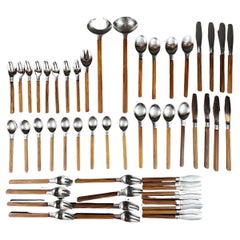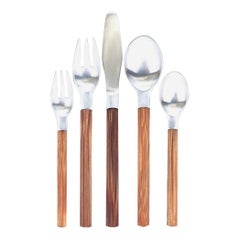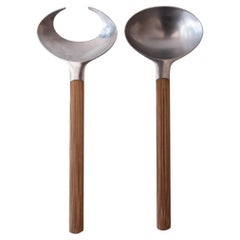Dansk Toke
Vintage 1950s Mid-Century Modern Tableware
Stainless Steel
Recent Sales
Vintage 1950s Danish Mid-Century Modern Tableware
Stainless Steel
Vintage 1960s Danish Mid-Century Modern Serving Pieces
Stainless Steel
20th Century Danish Scandinavian Modern Tableware
Stainless Steel
Jens Quistgaard for sale on 1stDibs
The postwar-era work of Danish sculptor and designer Jens Harald Quistgaard is still exceedingly popular in living rooms, dining rooms and kitchens in the United States, Europe and Japan, particularly in the homes of mid-century design enthusiasts. Having created serving pieces and barware for Dansk Designs for 30 years, Quistgaard produced striking Scandinavian modernist designs that married function with sophisticated form.
After demonstrating artistic talent at a young age, Quistgaard was gifted a forge and anvil so that he could work in his mother’s kitchen. He built toys, jewelry and hunting knives under his father’s tutelage. Later, he spent years learning from local artisans how to produce wood, metal, ceramic and glass models. Quistgaard’s career path solidified during his apprenticeship as a silversmith with legendary Danish silver firm Georg Jensen.
By 1954, Quistgaard had become known for his designs in Denmark when American entrepreneur and businessman, Ted Nierenberg, discovered his work. The two formed a partnership to mass-produce Quistgaard’s wares in New York while the designer remained in Copenhagen.
The long-distance relationship flourished for three decades, during which millions of Quistgaard pieces were manufactured in the factories of Dansk Designs, Nierenberg’s company. Owing primarily to the partnership between Dansk Designs and Quistgaard, many Americans became familiar with Scandinavian modernism. In the postwar era, American tastemakers sold the citizenry on the “Scandinavian dream,” suggesting that, like us, the inhabitants of the Nordic nations valued home, hearth, family and good craftsmanship and design, as well as democracy.
The designs for Quistgaard’s Købenstyle line and other collections during the mid-1950s were revolutionary, with bowls built like barrels and charming, lightweight monochrome tableware in enameled steel. Quistgaard utilized exceptional materials in the creation of his coveted cookware and serving pieces, opting for warm teak and exotic woods and reintroducing steel as a go-to option for kitchen wares.
Quistgaard’s designs won numerous awards and are held in the collections of museums all over the world. His work can be found in the Victoria & Albert Museum, the Louvre, the Museum of Modern Art and elsewhere.
Find vintage Jens Harald Quistgaard decorative objects, serveware and other furniture on 1stDibs.
Materials: Bamboo Furniture
Bamboo — the reed-like, woody grass revered the world over for its attractiveness, durability and unbeatable versatility — has a purity and elegance that Ming Dynasty dignitaries, European royals and workaday folks alike have appreciated for centuries. Antique and vintage bamboo furniture can help introduce an air of relaxation in any space, and pairs well with chinoiserie decor and a range of porcelain decorative objects.
So why is bamboo — in its many forms — so enduringly popular? The grass itself is classic-looking and pleasingly geometric, and it evokes a subtle exoticism that’s both glamorous and (due in large part to its sustainability) highly attainable.
Bamboo is harder than mahogany. It’s a rigid and hollow reed, and as such it is not rattan, which is dense, steamable and bendable, and has become its own ultimate decorative-arts chameleon over the years. But like rattan, bamboo is an organic material that provides a link to nature, helping us to bring a bit of the outside in, in an elegant yet no-frills way that seems comforting and familiar. Plus, bamboo’s lightness and slight irregularities make it the perfect counterpoint to heavy-feeling interiors.
For organic modern interiors — or any space that would benefit from a dose of the natural world — a variety of vintage bamboo outdoor furniture, side tables, dining chairs and more can be found on 1stDibs.
Finding the Right Tableware for You
While it isn’t always top of mind for some, antique and vintage tableware can enhance even the most informal meal. It has been an intimate part of how we’ve interacted with our food for millennia.
Tableware has played a basic but important role in everyday life. Ancient Egyptians used spoons (which are classified as flatware) made of ivory and wood, while Greeks and Romans, who gathered for banquets involving big meals and entertainment, ate with forks and knives. At the beginning of the 17th century, however, forks were still uncommon in American homes. Over time, tableware has thankfully evolved and today includes increasingly valuable implements.
Tableware refers to the tools people use to set the table, including serving pieces, dinner plates and more. It encompasses everything from the intricate and elaborate to the austere and functional, yet are all what industrial product designer Jasper Morrison might call “Super Normal” — anonymous objects that are too useful to be considered banal.
There are four general categories of tableware — serveware, dinnerware, drinkware and, lastly, flatware, which is commonly referred to as silverware or cutlery. Serveware includes serving bowls, platters, gravy boats, casserole pans and ladles. Most tableware is practical, but it can also be decorative. And decorative objects count as tableware too. Even though they don’t fit squarely into one of the four categories, vases, statues and floral arrangements are traditional centerpieces.
Drinkware appropriately refers to the vessels we use for our beverages — mugs, cups and glasses. There is a good deal of variety that falls under this broad term. For example, your cheerful home bar or mid-century modern bar cart might be outfitted with a full range of vintage barware, which might include pilsner glasses and tumblers. Specialty cocktails are often served in these custom glasses, but they’re still a type of drinkware.
Every meal should be special — even if you’re using earthenware or stoneware for a casual lunch — but perhaps you’re hosting a dinner party to mark a specific event. The right high-quality tableware can bring a touch of luxury to your cuisine. Young couples, for example, traditionally add “fine china,” or porcelain, to their wedding registry as a commemoration of their union and likely wouldn’t turn down exquisite silver made by Tiffany & Co. or Georg Jensen.
It’s important to remember, however, that when you’re setting the dining room table to have fun with it. Just as you might mix and match your dining chairs, don’t be afraid to mix new and old or high and low with your tableware. On 1stDibs, find an extraordinary range of vintage and antique tableware to help elevate your meal as well as the mood and atmosphere of your entire dining room.


